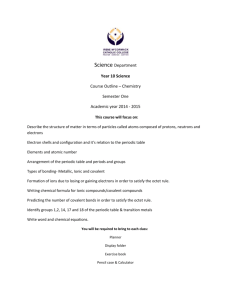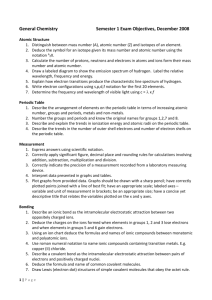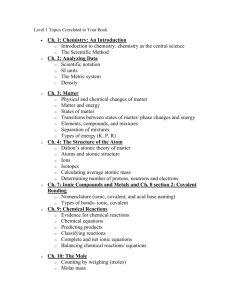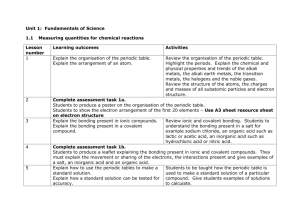DOC
advertisement
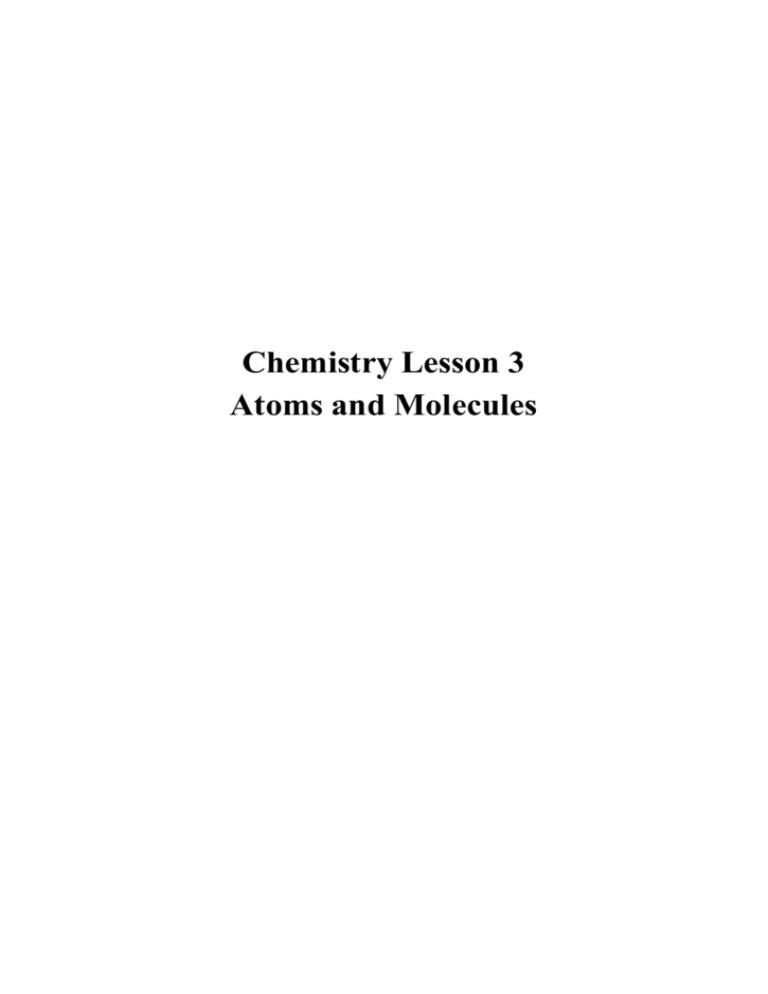
Chemistry Lesson 3 Atoms and Molecules Learning Objectives: In this chapter you will learn: The organization and the predicting power of the modern periodic table. The atomic structure The electron configuration of an atom Ionic bonding and the characteristic properties of ionic compounds Covalent bonding and the characteristic properties of covalent compounds How to predict the shape of a molecule The types of intermolecular forces that hold molecules together. Substances that have the giant covalent structure. Hybridization of atomic orbitals and its implications to the molecular shape. Suggested Time Allocation: Part Theme Powerpoint Slides Suggested time allocation: 1 Atoms, Elements, Molecules and Compounds 2–8 20 mins 2 The Modern Periodic Table 9 – 18 75 mins 3 Periodicity 19 – 22 30 mins 4 Atomic Structure 23 – 32 60 mins 5 Electron Arrangements 33 – 42 45 mins 6 Ionic Bond and Ionic Compounds 43 – 59 75 mins 7 Covalent Bond and Covalent Compounds 60 – 66 70 mins 8 Shape of a Molecule 67 – 72 45 mins 9 Intermolecular Forces 73 – 88 90 mins 10 Covalent Bond, Atomic Orbital, Molecular Orbital and Hybridization 89 – 113 90 mins Total time suggested: 600 mins (10 hours) Teachers Notes: 1. 2. 3. 4. 5. 6. 7. 8. 9. This module covered quite a large numbers of topics about the Modern Periodic Table, Atomic Structures, Molecular Structures, and Chemical Bonding. If time is allowed, teachers are suggested to break down the module into several shorter sessions. It allows students to learn the topics one by one, and so they can have more time to digest the contents. Knowledge prerequisites – it is recommended that the students have previously learnt the following concepts: - Differences between elements and compounds. - The existence of some common elements such as hydrogen, oxygen, nitrogen, carbon and chlorine. - The three states of matter. (Part 2) Students should know about the existence of semi-metals/metalloids, and can remember 1-2 common examples. They should recognize that metalloids have some typical properties that lie between those of metals and non-metals. However, it is not necessary to discuss the details of these characteristic properties, such as why the metalloids have semi-conducting property. (Part 2) Students should recognize all elements in Group VIII are extremely chemically inert. It helps them to recognize the phenomenon that most elements have strong tendency to form stable ions. (Part 3) Students should recognize that the periodicities observed in the Periodic table are only general trends, and minor discrepancies can frequently be observed among these general trends. (Part 4) Students should be reminded about the difference between relative atomic mass, isotopic mass and mass number. (Part 5) Students should recognize that the chemical and physical properties of an element are closely related to its electron arrangement. (Part 5) Slides 39-41 are included to illustrate why the outermost electrons of potassium and calcium are put into the fourth shell instead of the partially filled 3rd shell. Teachers may choose to skip this part if they consider this part is a bit side-tracked, or found the students have difficulty to follow. (Part 6) Students should recognize that the formation of all types of chemical bondings and intermolecular attractions (no matter whether they are ionic bonds, covalent bonds, hydrogen bonding, polar-polar attraction or van der Waals’ forces) are due to the electrostatic attractions between opposite charges. Different types of bonding/attractions give rise to attractions of different strength. 10. (Part 9) Students should be reminded that a molecule having polar covalent bonds can, as a whole, be overall non-polar (e.g. BF3). The polarity resulted from the polar bonds cancels with each other. 11. (Part 9) Larger molecules have larger polarizability, giving rise to stronger induced-dipole induced-dipole attraction. 12. (Part 9) Students should recognize that although non-polar molecules have no permanent dipole moments, the electrons in a molecule move around continuously and randomly. The random movements of electrons produce tiny and instantaneous diploles for the molecules, and make the molecules weakly attract to each other. 13. (Part 10) This part is an advanced part. Teachers may choose to skip this part. 14. (Part 10) Students should recognize that there are two different types of bonds ( and ) present in a multiple covalent bond. 15. (Part 10) Students should recognize that the geometry of a compound is determined by the state of hybridization of its constituting atoms. . Suggested Web-resources for Further Study: 1. http://www.webelements.com/ - WebElements: The periodic table on the web 2. http://en.wikipedia.org/wiki/Periodic_table 3. 4. 5. 6. 7. 8. - Wikipedia – Periodic table http://www.college-cram.com/study/search/index.php?presentation=Atoms%20a nd%20Molecules&owner=23&breadcrumb - Atoms and Molecules – web resources at College-Cram.com http://www.daviddarling.info/encyclopedia/B/Bohr_atom.html - The Internet Encyclopedia of Science – Bohr atom http://www.daviddarling.info/encyclopedia/R/Rutherfords_experiment_and_ato mic_model.html - The Internet Encyclopedia of Science - Rutherford’s experiment and atomic model http://www.bbc.co.uk/schools/gcsebitesize/science/add_ocr/patterns/electronsrev 1.shtml - BBC GCSE Bitesize – Electron arrangement http://www.saskschools.ca/curr_content/chem30/modules/module2/lesson2/perio dtableandconf.htm - Periodic table and electron arrangement http://www.chem1.com/acad/webtext/chembond/ 9. Chem1 Virtual Textbook – Chemical Bonding and Molecular Structure http://www.chem.ufl.edu/~itl/2045/lectures/lec_g.html - Intermolecular forces 10. http://chemistry.boisestate.edu/people/richardbanks/inorganic/bonding%20and% 20hybridization/bonding_hybridization.htm - Bonding and hybridization 11. http://www.mhhe.com/physsci/chemistry/essentialchemistry/flash/hybrv18.swf Hybridization of orbitals – animations
